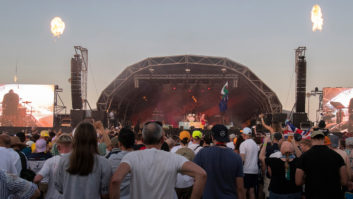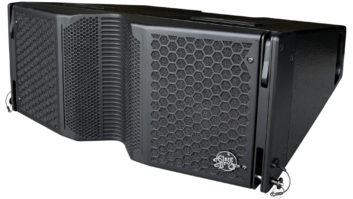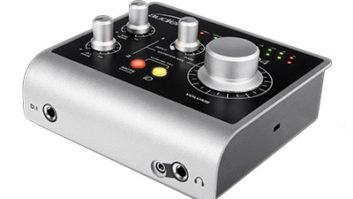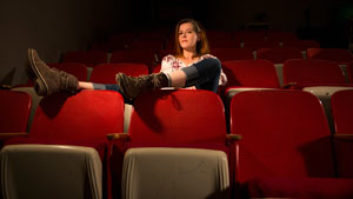In their constant quest for higher fidelity, better coverage and greater SPLs, the designers of large-scale sound reinforcement systems have often had occasion to review the theoretical principles of sound propagation. One result has been the rediscovery of the line array, the principles of which were first described by 19th-century acoustics pioneer Lord Rayleigh.
Christian Heil is widely acknowledged as the modern champion of line array systems, and the L-Acoustic V-DOSC[R] systems he designed and developed have met with wide acceptance. No doubt prompted by the success of the V-DOSC system, Clair Brothers introduced its I-4 line array P.A. system last year. And, on page 148, Mix sound reinforcement editor Mark Frink previews the latest system from JBL, also a line array.
Electro-Voice has not been idle. Just weeks before the AES convention, Mix spoke with Alan Shirley, E-V’s VP of marketing for the speaker and microphone group, and VP of engineering Mike O’Neill about the X-Line system, E-V’s first large-scale line array system.
E-V obviously wanted a system that would outperform the V-DOSC. Another important design goal was flat “power response” – a smooth frequency response throughout the horizontal and vertical coverage patterns. “We also wanted to extend directional control as low as possible, especially through the vocal fundamentals,” notes O’Neill. “And we wanted more horsepower on the high end.”
The X-Line design started out with two 15-inch woofers mounted in the walls of the midrange horn, which in turn loaded a single 12-inch woofer. Offset to one side of the cabinet are three HF compression drivers with 3-inch diaphragms loaded by individual 1.3-inch throats. “We wanted to keep the vocal range as clean as we could,” says O’Neill, explaining the asymmetry. “In a mid-bass horn, when you stack the high-frequency drivers in the center it starts to act like two horn mouths rather than one, and you start to get lobing errors.”
In its initial form, the X-Line system had a high-profile, if less than ideal, debut on the Diana Ross & The Supremes’ world tour, which was canceled in late June. Lars Brogaard, production manager and FOH mixer for that tour is at this point, the only professional FOH mixer to have used the system. “Bob Doyle at Midas called me to ask if I would consider being involved with the E-V line array system,” recalls Brogaard. “I flew to Buchanan and heard the prototype boxes and was amazed at how great it sounded with just four boxes. We did some A/B testing with another line array system outdoors in Michigan, so it was very easy to hear what was good and what was bad.
“We spent about two-and-a- half weeks with the P.A. in rehearsals,” he recalls. “By the time we got on tour, it was very much a finished product, but we also found that we could make some improvements.” Brogaard and his colleague Taidus Vallandi gave the E-V engineers their feedback, and after the tour ended Vallandi went to Buchanan to work with E-V engineer Dave Carlson on making the necessary changes.
The major change was in the midrange horn, where the single 12-inch woofer was replaced with two 8-inch drivers, vertically oriented. “We were pleased with lower part of the midrange,” explains O’Neill. “But the upper part was compromised by fundamental breakup modes, which start at a lower frequency with a larger driver.” Another significant change is that the three HF drivers are now mounted on a common throat manifold. “The wave fronts are shaped to something that is vertically planar and then sum onto a single horn,” explains O’Neill. “That single horn will allow us to go wider than 90 degrees.”
The new configuration has not yet been tested in show conditions, but Brogaard predicts success. “Especially in the low end and the very high end, the X-Line system is so much more powerful and truer – more open sounding,” he says. “It was also amazingly easy to fly. The way it goes in and out of buildings is just great – there are a lot less nuts and bolts and people involved in flying this system.” The X-Line’s rigging system is the same as on E-V’s X-Array system and includes a “hinge” on the cabinet rear and adjustable straps on the front.





